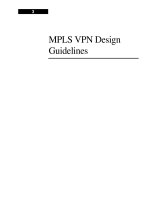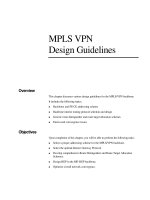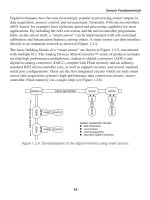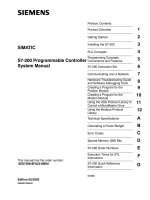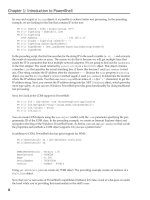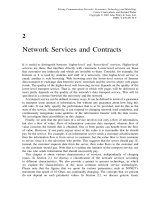Tài liệu Complete Digital Design P2 ppt
Bạn đang xem bản rút gọn của tài liệu. Xem và tải ngay bản đầy đủ của tài liệu tại đây (306.29 KB, 20 trang )
10 Digital Fundamentals
is irrelevant: . It may appear tempting to create a product term consisting of the three boxes on
the bottom edge of the K-map. This is not valid because it does not result in all boxes sharing a com-
mon product relationship, and therefore violates the power-of-two rule mentioned previously. Upon
completing the K-map, all product terms are summed to yield a final and simplified Boolean equa-
tion that relates the input variables and the output: .
Functions of four variables are just as easy to solve using a K-map. Beyond four variables, it is
preferable to break complex functions into smaller subfunctions and then combine the Boolean
equations once they have been determined. Figure 1.6 shows an example of a completed Karnaugh
map for a hypothetical function of four variables. Note the overlap between several groups to
achieve a simplified set of product terms. The lager a group is, the fewer unique terms will be re-
quired to represent its logic. There is nothing to lose and something to gain by forming a larger
group whenever possible. This K-map has four product terms that are summed for a final result:
.
In both preceding examples, each result box in the truth table and Karnaugh map had a clearly de-
fined state. Some logical relationships, however, do not require that every possible result necessarily
be a one or a zero. For example, out of 16 possible results from the combination of four variables,
only 14 results may be mandated by the application. This may sound odd, but one explanation could
be that the particular application simply cannot provide the full 16 combinations of inputs. The spe-
cific reasons for this are as numerous as the many different applications that exist. In such circum-
stances these so-called
don’t care
results can be used to reduce the complexity of your logic.
Because the application does not care what result is generated for these few combinations, you can
arbitrarily set the results to 0s or 1s so that the logic is minimized. Figure 1.7 is an example that
modifies the Karnaugh map in Fig. 1.6 such that two don’t care boxes are present. Don’t care values
are most commonly represented with “x” characters. The presence of one x enables simplification of
the resulting logic by converting it to a 1 and grouping it with an adjacent 1. The other x is set to 0 so
that it does not waste additional logic terms. The new Boolean equation is simplified by removing B
from the last term, yielding . It is helpful to remember that x val-
ues can generally work to your benefit, because their presence imposes fewer requirements on the
logic that you must create to get the job done.
1.4 BINARY AND HEXADECIMAL NUMBERING
The fact that there are only two valid Boolean values, 1 and 0, makes the
binary
numbering system
appropriate for logical expression and, therefore, for digital systems. Binary is a base-2 system in
AC
1
1
1
1
0
1
0
0
A,B
0
1
00 01 11
10
FIGURE 1.5
Completed Karnaugh map for a
function of three variables.
1
1
1
1
1
1
0
0
A,B
C,D
00
01
00 01 11 10
0
0
0
0
0
1
1
0
11
10
FIGURE 1.6
Completed Karnaugh map for
function of four variables.
YBAC+=
Y A CB CABD ABCD++ +=
Y A CB CABD ACD++ +=
-Balch.book Page 10 Thursday, May 15, 2003 3:46 PM
Digital Logic 11
which only the digits 1 and 0 exist. Binary follows the same laws of mathematics as decimal, or
base-10, numbering. In decimal, the number 191 is understood to mean one hundreds plus nine tens
plus one ones. It has this meaning, because each digit represents a successively higher power of ten
as it moves farther left of the decimal point. Representing 191 in mathematical terms to illustrate
these increasing powers of ten can be done as follows:
191 = 1
×
10
2
+ 9
×
10
1
+ 1
×
10
0
Binary follows the same rule, but instead of powers of ten, it works on powers of two. The num-
ber 110 in binary (written as 110
2
to explicitly denote base 2) does not equal 110
10
(decimal).
Rather, 110
2
= 1
×
2
2
+ 1
×
2
1
+ 0
×
2
0
= 6
10
. The number 191
10
can be converted to binary by per-
forming successive division by decreasing powers of 2 as shown below:
191 ÷ 2
7
= 191 ÷ 128 = 1 remainder 63
63 ÷ 2
6
= 63 ÷ 64 = 0 remainder 63
63 ÷ 2
5
= 63 ÷ 32 = 1 remainder 31
31 ÷ 2
4
= 31 ÷ 16 = 1 remainder 15
15 ÷ 2
3
= 15 ÷ 8 = 1 remainder 7
7 ÷ 2
2
= 7 ÷ 4 = 1 remainder 3
3 ÷ 2
1
= 3 ÷ 2 = 1 remainder 1
1 ÷ 2
0
= 1 ÷ 1 = 1 remainder 0
The final result is that 191
10
= 10111111
2
. Each binary digit is referred to as a
bit
. A group of N
bits can represent decimal numbers from 0 to 2
N
– 1. There are eight bits in a
byte
, more formally
called an
octet
in certain circles, enabling a byte to represent numbers up to 2
8
– 1 = 255. The pre-
ceding example shows the eight power-of-two terms in a byte. If each term, or bit, has its maximum
value of 1, the result is 128 + 64 + 32 + 16 + 8 + 4 + 2 + 1 = 255.
While binary notation directly represents digital logic states, it is rather cumbersome to work
with, because one quickly ends up with long strings of ones and zeroes.
Hexadecimal
, or base 16
(
hex
for short), is a convenient means of representing binary numbers in a more succinct notation.
Hex matches up very well with binary, because one hex digit represents four binary digits, given that
1
1
1
1
1
1
0
0
A,B
C,D
00
01
00 01 11 10
x
0
x
0
0
1
1
0
11
10
FIGURE 1.7
Karnaugh map for function of four vari-
ables with two “don’t care” values.
-Balch.book Page 11 Thursday, May 15, 2003 3:46 PM
12Digital Fundamentals
2
4
= 16. A four-bit group is called a
nibble
. Because hex requires 16 digits, the letters “A” through
“F” are borrowed for use as hex digits beyond 9. The 16 hex digits are defined in Table 1.7.
The preceding example, 191
10
= 10111111
2
, can be converted to hex easily by grouping the eight
bits into two nibbles and representing each nibble with a single hex digit:
1011
2
= (8 + 2 + 1)
10
= 11
10
= B
16
1111
2
= (8 + 4 + 2 + 1)
10
= 15
10
= F
16
Therefore, 191
10
= 10111111
2
= BF
16
. There are two common prefixes, 0x and $, and a common
suffix, h, that indicate hex numbers. These styles are used as follows: BF
16
= 0xBF = $BF = BFh. All
three are used by engineers, because they are more convenient than appending a subscript “16” to
each number in a document or computer program. Choosing one style over another is a matter of
preference.
Whether a number is written using binary or hex notation, it remains a string of bits, each of
which is 1 or 0. Binary numbering allows arbitrary data processing algorithms to be reduced to
Boolean equations and implemented with logic gates. Consider the equality comparison of two four-
bit numbers, M and N.
“If M = N, then the equality test is true.”
Implementing this function in gates first requires a means of representing the individual bits that
compose M and N. When a group of bits are used to represent a common entity, the bits are num-
bered in ascending or descending order with zero usually being the smallest index. The bit that rep-
resents 2
0
is termed the
least-significant bit
, or LSB, and the bit that represents the highest power of
two in the group is called the
most-significant bit
, or MSB. A four-bit quantity would have the MSB
represent 2
3
. M and N can be ordered such that the MSB is bit number 3, and the LSB is bit number
0. Collectively, M and N may be represented as M[3:0] and N[3:0] to denote that each contains four
bits with indices from 0 to 3. This presentation style allows any arbitrary bit of M or N to be
uniquely identified with its index.
Turning back to the equality test, one could derive the Boolean equation using a variety of tech-
niques. Equality testing is straightforward, because M and N are equal only if each digit in M
matches its corresponding bit position in N. Looking back to Table 1.3, it can be seen that the XNOR
gate implements a single-bit equality check. Each pair of bits, one from M and one from N, can be
passed through an XNOR gate, and then the four individual equality tests can be combined with an
AND gate to determine overall equality,
The four-bit equality test can be drawn schematically as shown in Fig. 1.8.
TABLE
1.7 Hexadecimal Digits
Decimal value 0123456789101112131415
Hex digit 0123456789ABCDEF
Binary nibble 0000 0001 0010 0011 0100 0101 0110 0111 1000 1001 1010 1011 1100 1101 1110 1111
YM3[] N3[]⊕ &M 2[] N2[]⊕ &M 1[] N1[]⊕ &M 0[] N0[]⊕=
-Balch.book Page 12 Thursday, May 15, 2003 3:46 PM
Digital Logic 13
Logic to compare one number against a constant is simpler than comparing two numbers, because
the number of inputs to the Boolean equation is cut in half. If, for example, one wanted to compare
M[3:0] to a constant 1001
2
(9
10
), the logic would reduce to just a four-input AND gate with two in-
verted inputs:
When working with computers and other digital systems, numbers are almost always written in
hex notation simply because it is far easier to work with fewer digits. In a 32-bit computer, a value
can be written as either 8 hex digits or 32 bits. The computer’s logic always operates on raw binary
quantities, but people generally find it easier to work in hex. An interesting historical note is that hex
was not always the common method of choice for representing bits. In the early days of computing,
through the 1960s and 1970s, octal (base-8) was used predominantly. Instead of a single hex digit
representing four bits, a single octal digit represents three bits, because 2
3
= 8. In octal, 191
10
=
277
8
. Whereas bytes are the lingua franca of modern computing, groups of two or three octal digits
were common in earlier times.
Because of the inherent binary nature of digital systems, quantities are most often expressed in or-
ders of magnitude that are tied to binary rather than decimal numbering. For example, a “round num-
ber” of bytes would be 1,024 (2
10
) rather than 1000 (10
3
). Succinct terminology in reference to
quantities of data is enabled by a set of standard prefixes used to denote order of magnitude. Further-
more, there is a convention of using a capital B to represent a quantity of bytes and using a lower-
case b to represent a quantity of bits. Commonly observed prefixes used to quantify sets of data are
listed in Table 1.8. Many memory chips and communications interfaces are expressed in units of
bits. One must be careful not to misunderstand a specification. If you need to store 32 MB of data, be
sure to use a 256 Mb memory chip rather than a 32 Mb device!
TABLE
1.8 Common Binary Magnitude Prefixes
Prefix Definition Order of Magnitude Abbreviation Usage
Kilo
(1,024)
1
= 1,024 2
10
kkB
Mega
(1,024)
2
= 1,048,576 2
20
MMB
Giga
(1,024)
3
= 1,073,741,824 2
30
GGB
Tera
(1,024)
4
= 1,099,511,627,776 2
40
TTB
Peta
(1,024)
5
= 1,125,899,906,842,624 2
50
PPB
Exa
(1,024)
6
= 1,152,921,504,606,846,976 2
60
EEB
M[3]
N[3]
M[2]
N[2]
M[1]
N[1]
M[0]
N[0]
Y
FIGURE 1.8
Four-bit equality logic.
yM3[]&M 2[]&M 1[]&M 0[]=
-Balch.book Page 13 Thursday, May 15, 2003 3:46 PM
14 Digital Fundamentals
The majority of digital components adhere to power-of-two magnitude definitions. However,
some industries break from these conventions largely for reasons of product promotion. A key exam-
ple is the hard disk drive industry, which specifies prefixes in decimal terms (e.g., 1 MB = 1,000,000
bytes). The advantage of doing this is to inflate the apparent capacity of the disk drive: a drive that
provides 10,000,000,000 bytes of storage can be labeled as “10 GB” in decimal terms, but it would
have to be labeled as only 9.31 GB in binary terms (10
10
÷ 2
30
= 9.31).
1.5 BINARY ADDITION
Despite the fact that most engineers use hex data representation, it has already been shown that logic
gates operate on strings of bits that compose each unit of data. Binary arithmetic is performed ac-
cording to the same rules as decimal arithmetic. When adding two numbers, each column of digits is
added in sequence from right to left and, if the sum of any column is greater than the value of the
highest digit, a carry is added to the next column. In binary, the largest digit is 1, so any sum greater
than 1 will result in a carry. The addition of 111
2
and 011
2
(7 + 3 = 10) is illustrated below.
In the first column, the sum of two ones is 2
10
, or 10
2
, resulting in a carry to the second column.
The sum of the second column is 3
10
, or 11
2
, resulting in both a carry to the next column and a one
in the sum. When all three columns are completed, a carry remains, having been pushed into a new
fourth column. The carry is, in effect, added to leading 0s and descends to the sum line as a 1.
The logic to perform binary addition is actually not very complicated. At the heart of a 1-bit adder
is the XOR gate, whose result is the sum of two bits without the associated carry bit. An XOR gate
generates a 1 when either input is 1, but not both. On its own, the XOR gate properly adds 0 + 0, 0 +
1, and 1 + 0. The fourth possibility, 1 + 1 = 2, requires a carry bit, because 2
10
= 10
2
. Given that a
carry is generated only when both inputs are 1, an AND gate can be used to produce the carry. A so-
called half-adder is represented as follows:
This logic is called a half-adder because it does only part of the job when multiple bits must be
added together. Summing multibit data values requires a carry to ripple across the bit positions start-
ing from the LSB. The half-adder has no provision for a carry input from the preceding bit position.
A full-adder incorporates a carry input and can therefore be used to implement a complete summa-
tion circuit for an arbitrarily large pair of numbers. Table 1.9 lists the complete full-adder input/out-
put relationship with a carry input (C
IN
) from the previous bit position and a carry output (C
OUT
) to
the next bit position. Note that all possible sums from zero to three are properly accounted for by
combining C
OUT
and sum. When C
IN
= 0, the circuit behaves exactly like the half-adder.
1110 carry bits
111
+ 011
1010
sum A B⊕=
carry AB=
-Balch.book Page 14 Thursday, May 15, 2003 3:46 PM
Digital Logic 15
Full-adder logic can be expressed in a variety of ways. It may be recognized that full-adder logic
can be implemented by connecting two half-adders in sequence as shown in Fig. 1.9. This full-adder
directly generates a sum by computing the XOR of all three inputs. The carry is obtained by combin-
ing the carry from each addition stage. A logical OR is sufficient for C
OUT
, because there can never
be a case in which both half-adders generate a carry at the same time. If the A + B half-adder gener-
ates a carry, the partial sum will be 0, making a carry from the second half-adder impossible. The as-
sociated logic equations are as follows:
Equivalent logic, although in different form, would be obtained using a K-map, because XOR/
XNOR functions are not direct results of K-map AND/OR solutions.
1.6 SUBTRACTION AND NEGATIVE NUMBERS
Binary subtraction is closely related to addition. As with many operations, subtraction can be imple-
mented in a variety of ways. It is possible to derive a Boolean equation that directly subtracts two
numbers. However, an efficient solution is to add the negative of the subtrahend to the minuend
TABLE
1.9 1-Bit Full-Adder Truth Table
C
IN
AB
C
OUT
Sum
000 0 0
001 0 1
010 0 1
011 1 0
100 0 1
101 1 0
110 1 0
111 1 1
A
B
C
IN
sum
C
OUT
FIGURE 1.9
Full-adder logic diagram.
sum A B C
IN
⊕⊕=
C
OUT
AB A B⊕()C
IN
[]+=
-Balch.book Page 15 Thursday, May 15, 2003 3:46 PM
16 Digital Fundamentals
rather than directly subtracting the subtrahend from the minuend. These are, of course, identical op-
erations: A – B = A + (–B). This type of arithmetic is referred to as subtraction by addition of the
two’s complement. The two’s complement is the negative representation of a number that allows the
identity A – B = A + (–B) to hold true.
Subtraction requires a means of expressing negative numbers. To this end, the most-significant
bit, or left-most bit, of a binary number is used as the sign-bit when dealing with signed numbers. A
negative number is indicated when the sign-bit equals 1. Unsigned arithmetic does not involve a
sign-bit, and therefore can express larger absolute numbers, because the MSB is merely an extra
digit rather than a sign indicator.
The first step in performing two’s complement subtraction is to convert the subtrahend into a neg-
ative equivalent. This conversion is a two-step process. First, the binary number is inverted to yield a
one’s complement. Then, 1 is added to the one’s complement version to yield the desired two’s com-
plement number. This is illustrated below:
Observe that the unsigned four-bit number that can represent values from 0 to 15
10
now represents
signed values from –8 to 7. The range about zero is asymmetrical because of the sign-bit and the fact
that there is no negative 0. Once the two’s complement has been obtained, subtraction is performed
by adding the two’s complement subtrahend to the minuend. For example, 7 – 5 = 2 would be per-
formed as follows, given the –5 representation obtained above:
Note that the final carry-bit past the sign-bit is ignored. An example of subtraction with a negative
result is 3 – 5 = –2.
Here, the result has its sign-bit set, indicating a negative quantity. We can check the answer by calcu-
lating the two’s complement of the negative quantity.
0101Original number (5)
1010One’s complement
+0001Add one
1011Two’s complement (–5)
11110Carry bits
0111Minuend (7)
+1011“Subtrahend” (–5)
0010Result (2)
1 1 0 Carry bits
0011Minuend (3)
+1011“Subtrahend” (–5)
1110Result (–2)
-Balch.book Page 16 Thursday, May 15, 2003 3:46 PM
Digital Logic 17
This check succeeds and shows that two’s complement conversions work “both ways,” going back
and forth between negative and positive numbers. The exception to this rule is the asymmetrical case
in which the largest negative number is one more than the largest positive number as a result of the
presence of the sign-bit. A four-bit number, therefore, has no positive counterpart of –8. Similarly, an
8-bit number has no positive counterpart of –128.
1.7 MULTIPLICATION AND DIVISION
Multiplication and division follow the same mathematical rules used in decimal numbering. How-
ever, their implementation is substantially more complex as compared to addition and subtraction.
Multiplication can be performed inside a computer in the same way that a person does so on paper.
Consider 12 × 12 = 144.
The multiplication process grows in steps as the number of digits in each multiplicand increases,
because the number of partial products increases. Binary numbers function the same way, but there
easily can be many partial products, because numbers require more digits to represent them in binary
versus decimal. Here is the same multiplication expressed in binary (1100 × 1100 = 10010000):
1110Original number (–2)
0001One’s complement
+0001Add one
0010Two’s complement (2)
12
X12
24
Partial product × 10
0
+12
Partial product × 10
1
1 4 4 Final product
1100
X1100
0000
Partial product × 2
0
0000
Partial product × 2
1
1100
Partial product × 2
2
+1100
Partial product × 2
3
10010000Final product
-Balch.book Page 17 Thursday, May 15, 2003 3:46 PM

